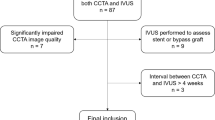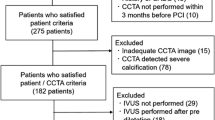Abstract
Several studies have suggested a link between epicardial adipose tissue (EAT) volume and high-risk plaques (HRPs); however, little is known about the association between EAT volume and HRP progression in non-culprit lesions (NCLs). Therefore, we evaluated whether EAT can independently predict HRP characteristic progression in NCLs by coronary computed tomography angiography (CCTA). In this single-centre trial, we analysed 131 consecutive patients (median age 61 years, male 72.52%) undergoing CCTA with percutaneous coronary intervention (PCI) for culprit lesions. All patients were scheduled to undergo follow-up CCTA 12 months after PCI. HRP features, including positive remodelling, low attenuation plaque, spotty calcification, and napkin-ring sign, along with EAT volume, were assessed by CCTA. The numbers of HRP features were compared between baseline and follow-up CCTA to detect HRP progression in NCLs, and patients were classified into two groups based on HRP progression. Logistic regression analysis was used to evaluate whether EAT volume was independently associated with HRP progression in NCLs. Overall, 23 of 131 patients who underwent two CCTAs exhibited HRP progression in NCLs (17.6%). Logistic regression analysis showed that a higher baseline EAT volume was associated with NCL HRP progression (odds ratio 1.019, 95% confidence interval 1.009–1.029, P < 0.001). The cut-off value for baseline EAT volume for NCL HRP progression was 107 ml based on receiver-operator characteristic curve analyses, and the area under the curve was 0.66. Baseline EAT volume was identified as an independent predictor of NCL HRP progression.




Similar content being viewed by others
References
Glaser R, Selzer F, Faxon DP, Laskey WK, Cohen HA, Slater J, Detre KM, Wilensky RL (2005) Clinical progression of incidental, asymptomatic lesions discovered during culprit vessel coronary intervention. Circulation 111:143–149
Motoyama S, Ito H, Sarai M, Kondo T, Kawai H, Nagahara Y, Harigaya H, Kan S, Anno H, Takahashi H, Naruse H, Ishii J, Hecht H, Shaw LJ, Ozaki Y, Narula J (2015) Plaque characterization by coronary computed tomography angiography and the likelihood of acute coronary events in mid-term follow-up. J Am Coll Cardiol 66:337–346
Noyes AM, Dua K, Devadoss R, Chhabra L (2014) Cardiac adipose tissue and its relationship to diabetes mellitus and cardiovascular disease. World. J Diabetes 5:868–876
Nakazato R, Dey D, Cheng VY, Gransar H, Slomka PJ, Hayes SW, Thomson LE, Friedman JD, Min JK, Berman DS (2012) Epicardial fat volume and concurrent presence of both myocardial ischemia and obstructive coronary artery disease. Atherosclerosis 221:422–426
Alexopoulos N, McLean DS, Janik M, Arepalli CD, Stillman AE, Raggi P (2010) Epicardial adipose tissue and coronary artery plaque characteristics. Atherosclerosis 210:150–154
Greif M, Becker A, von Ziegler F, Lebherz C, Lehrke M, Broedl UC, Tittus J, Parhofer K, Becker C, Reiser M, Knez A, Leber AW (2009) Pericardial adipose tissue determined by dual source ct is a risk factor for coronary atherosclerosis. Arterioscler Thromb Vasc Biol 29:781–786
Rosito GA, Massaro JM, Hoffmann U, Ruberg FL, Mahabadi AA, Vasan RS, O’Donnell CJ, Fox CS (2008) Pericardial fat, visceral abdominal fat, cardiovascular disease risk factors, and vascular calcification in a community-based sample: The framingham heart study. Circulation 117:605–613
Arbab-Zadeh A, Nakano M, Virmani R, Fuster V (2012) Acute coronary events. Circulation 125:1147–1156
Lee AM, Beaudoin J, Engel LC, Sidhu MS, Abbara S, Brady TJ, Hoffmann U, Ghoshhajra BB (2013) Assessment of image quality and radiation dose of prospectively ecg-triggered adaptive dual-source coronary computed tomography angiography (ccta) with arrhythmia rejection algorithm in systole versus diastole: A retrospective cohort study. Int J Cardiovasc Imaging 29:1361–1370
Stone GW, Maehara A, Lansky AJ, de Bruyne B, Cristea E, Mintz GS, Mehran R, McPherson J, Farhat N, Marso SP, Parise H, Templin B, White R, Zhang Z, Serruys PW, Investigators P (2011) A prospective natural-history study of coronary atherosclerosis. N Engl J Med 364:226–235
Han Y, Jing J, Tu S, Tian F, Xue H, Chen W, Chen J, Reiber JH, Chen Y (2014) St elevation acute myocardial infarction accelerates non-culprit coronary lesion atherosclerosis. Int J Cardiovasc Imaging 30:253–261
Xia Y, Junjie Y, Ying Z, Bai H, Qi W, Qinhua J, Yundai C (2013) Accuracy of 128-slice dual-source ct using high-pitch spiral mode for the assessment of coronary stents: First in vivo experience. Eur J Radiol 82:617–622
Papadopoulou SL, Neefjes LA, Garcia-Garcia HM, Flu WJ, Rossi A, Dharampal AS, Kitslaar PH, Mollet NR, Veldhof S, Nieman K, Stone GW, Serruys PW, Krestin GP, de Feyter PJ Natural history of coronary atherosclerosis by multislice computed tomography. JACC Cardiovasc Imaging 2012;5:S28–37.
Hoffmann U, Moselewski F, Nieman K, Jang IK, Ferencik M, Rahman AM, Cury RC, Abbara S, Joneidi-Jafari H, Achenbach S, Brady TJ (2006) Noninvasive assessment of plaque morphology and composition in culprit and stable lesions in acute coronary syndrome and stable lesions in stable angina by multidetector computed tomography. J Am Coll Cardiol 47:1655–1662
Gauss S, Achenbach S, Pflederer T, Schuhback A, Daniel WG, Marwan M (2011) Assessment of coronary artery remodelling by dual-source ct: A head-to-head comparison with intravascular ultrasound. Heart 97:991–997
Motoyama S, Kondo T, Sarai M, Sugiura A, Harigaya H, Sato T, Inoue K, Okumura M, Ishii J, Anno H, Virmani R, Ozaki Y, Hishida H, Narula J (2007) Multislice computed tomographic characteristics of coronary lesions in acute coronary syndromes. J Am Coll Cardiol 50:319–326
Motoyama S, Sarai M, Harigaya H, Anno H, Inoue K, Hara T, Naruse H, Ishii J, Hishida H, Wong ND, Virmani R, Kondo T, Ozaki Y, Narula J (2009) Computed tomographic angiography characteristics of atherosclerotic plaques subsequently resulting in acute coronary syndrome. J Am Coll Cardiol 54:49–57
Kashiwagi M, Tanaka A, Kitabata H, Tsujioka H, Kataiwa H, Komukai K, Tanimoto T, Takemoto K, Takarada S, Kubo T, Hirata K, Nakamura N, Mizukoshi M, Imanishi T, Akasaka T Feasibility of noninvasive assessment of thin-cap fibroatheroma by multidetector computed tomography. JACC Cardiovasc Imaging 2009;2:1412–1419.
Kitagawa T, Yamamoto H, Horiguchi J, Ohhashi N, Tadehara F, Shokawa T, Dohi Y, Kunita E, Utsunomiya H, Kohno N, Kihara Y: Characterization of noncalcified coronary plaques and identification of culprit lesions in patients with acute coronary syndrome by 64-slice computed tomography. JACC Cardiovasc Imaging 2009;2:153–160.
Maurovich-Horvat P, Hoffmann U, Vorpahl M, Nakano M, Virmani R, Alkadhi H The napkin-ring sign: Ct signature of high-risk coronary plaques? JACC Cardiovasc Imaging 2010;3:440–444.
Otsuka K, Fukuda S, Tanaka A, Nakanishi K, Taguchi H, Yoshikawa J, Shimada K, Yoshiyama M Napkin-ring sign on coronary ct angiography for the prediction of acute coronary syndrome. JACC Cardiovasc Imaging 2013;6:448–457.
Lu MT, Park J, Ghemigian K, Mayrhofer T, Puchner SB, Liu T, Fleg JL, Udelson JE, Truong QA, Ferencik M, Hoffmann U (2016) Epicardial and paracardial adipose tissue volume and attenuation—association with high-risk coronary plaque on computed tomographic angiography in the romicat ii trial. Atherosclerosis 251:47–54
Mahabadi AA, Berg MH, Lehmann N, Kalsch H, Bauer M, Kara K, Dragano N, Moebus S, Jockel KH, Erbel R, Mohlenkamp S (2013) Association of epicardial fat with cardiovascular risk factors and incident myocardial infarction in the general population: The heinz nixdorf recall study. J Am Coll Cardiol 61:1388–1395
Puchner SB, Liu T, Mayrhofer T, Truong QA, Lee H, Fleg JL, Nagurney JT, Udelson JE, Hoffmann U, Ferencik M (2014) High-risk plaque detected on coronary ct angiography predicts acute coronary syndromes independent of significant stenosis in acute chest pain: Results from the romicat-ii trial. J Am Coll Cardiol 64:684–692
Gaur S, Ovrehus KA, Dey D, Leipsic J, Botker HE, Jensen JM, Narula J, Ahmadi A, Achenbach S, Ko BS, Christiansen EH, Kaltoft AK, Berman DS, Bezerra H, Lassen JF, Norgaard BL (2016) Coronary plaque quantification and fractional flow reserve by coronary computed tomography angiography identify ischaemia-causing lesions. Eur Heart J 37:1220–1227
Park HB, Heo R, o Hartaigh B, Cho I, Gransar H, Nakazato R, Leipsic J, Mancini GB, Koo BK, Otake H, Budoff MJ, Berman DS, Erglis A, Chang HJ, Min JK Atherosclerotic plaque characteristics by ct angiography identify coronary lesions that cause ischemia: A direct comparison to fractional flow reserve. JACC Cardiovasc Imaging 2015;8:1–10.
Matsushita K, Hibi K, Komura N, Akiyama E, Maejima N, Iwahashi N, Tsukahara K, Kosuge M, Ebina T, Sumita S, Umemura S, Kimura K (2016) Effects of 4 statins on regression of coronary plaque in acute coronary syndrome. Circ J 80:1634–1643
Inoue K, Motoyama S, Sarai M, Sato T, Harigaya H, Hara T, Sanda Y, Anno H, Kondo T, Wong ND, Narula J, Ozaki Y: Serial coronary ct angiography-verified changes in plaque characteristics as an end point: evaluation of effect of statin intervention. JACC Cardiovasc Imaging 2010;3:691–698.
Bourantas CV, Garcia-Garcia HM, Farooq V, Maehara A, Xu K, Genereux P, Diletti R, Muramatsu T, Fahy M, Weisz G, Stone GW, Serruys PW Clinical and angiographic characteristics of patients likely to have vulnerable plaques: Analysis from the prospect study. JACC Cardiovasc Imaging 2013;6:1263–1272.
Bayturan O, Kapadia S, Nicholls SJ, Tuzcu EM, Shao M, Uno K, Shreevatsa A, Lavoie AJ, Wolski K, Schoenhagen P, Nissen SE (2010) Clinical predictors of plaque progression despite very low levels of low-density lipoprotein cholesterol. J Am Coll Cardiol 55:2736–2742
Iacobellis G, Corradi D, Sharma AM: Epicardial adipose tissue: Anatomic, biomolecular and clinical relationships with the heart. Nat Clin Pract Cardiovasc Med 2005;2:536–543.
Baker AR, Silva NF, Quinn DW, Harte AL, Pagano D, Bonser RS, Kumar S, McTernan PG (2006) Human epicardial adipose tissue expresses a pathogenic profile of adipocytokines in patients with cardiovascular disease. Cardiovasc Diabetol 5:1
Silaghi A, Piercecchi-Marti MD, Grino M, Leonetti G, Alessi MC, Clement K, Dadoun F, Dutour A (2008) Epicardial adipose tissue extent: Relationship with age, body fat distribution, and coronaropathy. Obesity 16:2424–2430
Schlett CL, Ferencik M, Kriegel MF, Bamberg F, Ghoshhajra BB, Joshi SB, Nagurney JT, Fox CS, Truong QA, Hoffmann U (2012) Association of pericardial fat and coronary high-risk lesions as determined by cardiac ct. Atherosclerosis 222:129–134
Nakanishi K, Fukuda S, Tanaka A, Otsuka K, Jissho S, Taguchi H, Yoshikawa J, Shimada K (2014) Persistent epicardial adipose tissue accumulation is associated with coronary plaque vulnerability and future acute coronary syndrome in non-obese subjects with coronary artery disease. Atherosclerosis 237:353–360
Aprigliano G, Scuteri L, Iafelice I, Li Volsi L, Cuko B, Palloshi A, Pisani M, Bonizzato S, Bianchi M, Morici N (2015) Epicardial adipose tissue thickness and acute coronary syndrome: A matter of how much or how? Int J Cardiol 199:8–9
Lehman SJ, Schlett CL, Bamberg F, Lee H, Donnelly P, Shturman L, Kriegel MF, Brady TJ, Hoffmann U Assessment of coronary plaque progression in coronary computed tomography angiography using a semiquantitative score. JACC Cardiovasc Imaging 2009;2:1262–1270.
Author information
Authors and Affiliations
Corresponding author
Ethics declarations
Conflict of interest
There was no funding and no conflict of interest in this study. All procedures performed in studies involving human participants were in accordance with the ethical standards of the institutional and/or national research committee and with the 1964 Helsinki declaration and its later amendments or comparable ethical standards. Informed consent was obtained from all individual participants included in the study.
Rights and permissions
About this article
Cite this article
Tan, Y., Zhou, J., Zhou, Y. et al. Epicardial adipose tissue is associated with high-risk plaque feature progression in non-culprit lesions. Int J Cardiovasc Imaging 33, 2029–2037 (2017). https://doi.org/10.1007/s10554-017-1158-3
Received:
Accepted:
Published:
Issue Date:
DOI: https://doi.org/10.1007/s10554-017-1158-3




